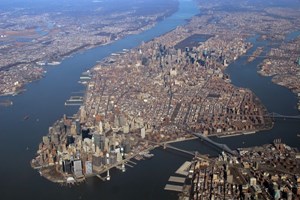
By the end of 2014, the writers and editors of Condé Nast will finish moving into the publishing company’s new 1.25 million-square-foot (116,000 sq m) headquarters in lower Manhattan. “One World Trade Center is about to open,” says Larry Silverstein, chairman of Silverstein Properties Inc.
That’s just the latest good news from that part of Manhattan, which is once again one of the most desirable neighborhoods in the world, despite surviving a hurricane, the global financial crisis, and the 9/11 attacks. New development has brought a stronger mix of residential, retail, and office space to the old commercial heart of New York City.
A Better Mix of Residential, Retail, and Transit
Once occupied primarily by Wall Street finance firms, lower Manhattan saw residential developers lured there with a mix of tax incentives and careful planning by the city that began to reshape downtown more than a decade ago. “The city more than doubled the residential population of downtown Manhattan since 2000,” said session moderator Carl Weisbrod, director of the New York City Department of City Planning and chairman of the New York City Planning Commission. Weisbrod also led the business improvement district for gowntown.
Wall Street is now lined with old, neoclassical, and Gothic towers that have been converted from obsolete office spaces to luxury apartments and condominiums. A few blocks closer to City Hall, there’s even a rippled, stainless-steel tower designed by star architect Frank Gehry. Developed by Forest City Ratner, the 76-story high rise includes 898 apartments and a New York City public elementary school.
Downtown is also getting an infusion of new retail space, including 300,000 square feet (28,000 sq m) that is now nearly fully leased at Brookfield Place, formerly known as the World Financial Center, next door to the World Trade Center. Brookfield Office Properties spent $300 million to renovate the common space at the center of the site and add retail space after its anchor office tenant, Merrill Lynch, foundered during the Financial Crisis.
“It’s a new identity for the center—it was a corporate fortress,” says Dennis Friedrich, chief executive officer, Brookfield Office Properties. “We are opening up to West Street.” All of the retail space was finished by spring 2013 and is now 80 percent leased to tenants including a Saks Fifth Avenue department store. The redevelopment succeeded despite flooding from Hurricane Sandy that poured more than a million square feet (93,000 sq m) of water into the eastern end of Brookfield’s properties. “It didn’t slow us down at all,” said Friedrich.
Another 500,000 square feet (46,000 sq m) of retail is opening at the World Trade Center complex, which includes much more than just office space. A new transit hub designed by another star architect, Santiago Calatrava, will open shortly on the site and offer access to several subway lines and PATH trains to New Jersey.
A large part of the office space at the World Trade Center is almost complete, after more than a decade of rebuilding after the 9/11 terror attacks. In addition to World Trade Center One, formerly known as the Freedom Tower, Tower 4 is also finished and 60 percent leased. “We are about to go forward with Tower 3,” says Silverstein. The rebuilding started with World Trade Center 7, while Silverstein still struggled with insurance companies and other stakeholders over the shape of redevelopment. “People told me not to do it. Even the insurance companies didn’t want to fund it,” said Silverstein. Construction started in April 2002 on an electrical substation at the site. Tenants were able to move into the completed building in May 2006. “The building filled quickly and became a huge financial success,” says Silverstein.
New demand for office space is also transforming downtown. “Who would have thought even five years ago that a company like Condé Nast would come to lower Manhattan?” asked Mary Ann Tighe, chief executive officer, New York Tri-State Region, CBRE Inc., who brokered the deal with Condé Nast.
Lower Manhattan has strengths that make it extremely desirable. To begin with, as more employees live in Brooklyn, lower Manhattan is closer to where they live. Condé Nast found that its employees will have a shorter commute to their new headquarters in lower Manhattan than their old offices in Times Square—even though Times Square is a transit hub of its own. “The suburbs aren’t in Westchester,” said Tighe. “The suburbs are now in Brooklyn and Queens.”
Redevelopment and retrofits also have helped make lower Manhattan more resilient against the threat of future storms like Hurricane Sandy. “We are much better today than we were two years ago to withstand another major storm,” says Bill Rudin, CEO and vice chairman of Rudin Management Company.
Office tenants are also drawn downtown by the new mix of retail and residential space. Thirty percent of employees in lower Manhattan now walk to work. The revived office sector now includes technology companies and publishing companies like Harper Collins. The amenities of lower Manhattan even include a new Four Seasons hotel. As a result, lower Manhattan is no longer a low-cost alternative to midtown Manhattan for adventurous companies seeking cheap office space. “If you’re within two blocks of a Four Seasons hotel, you’re not a pioneer,” said Tighe.
By Bendix Anderson
http://urbanland.uli.org/development-business/rebirth-manhattans-downtown/